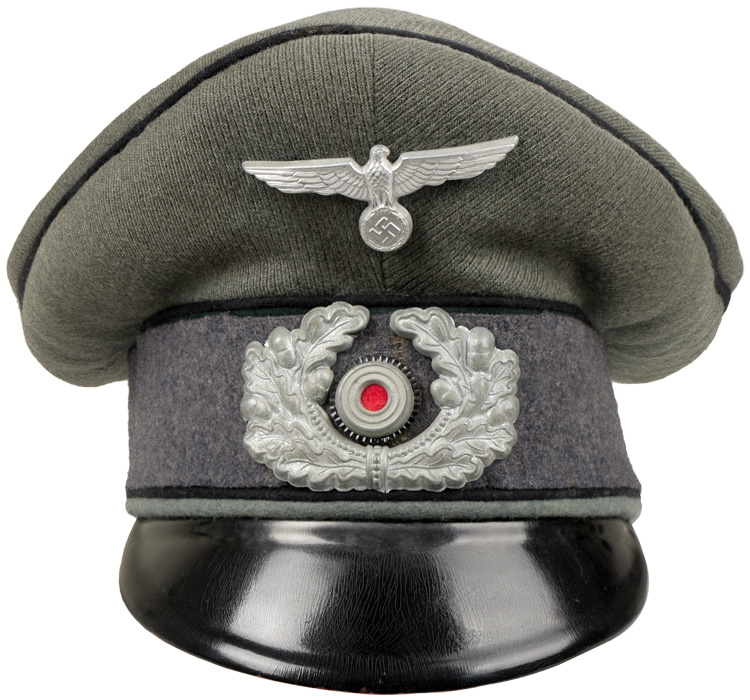
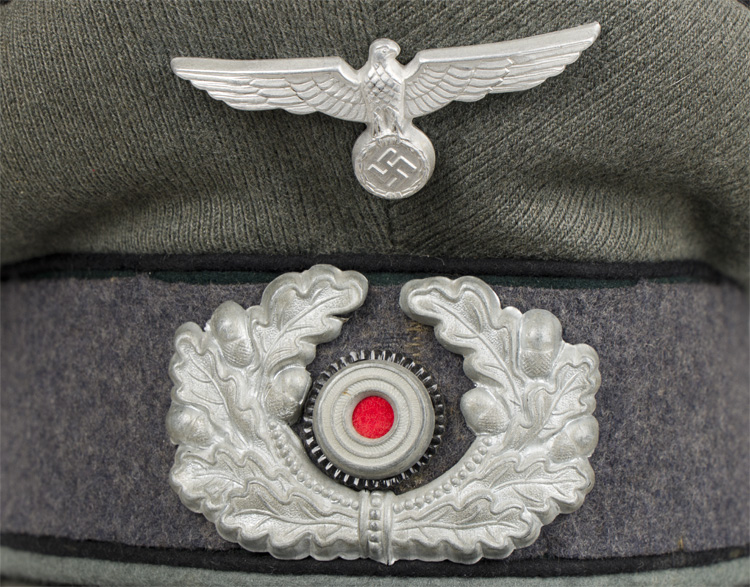
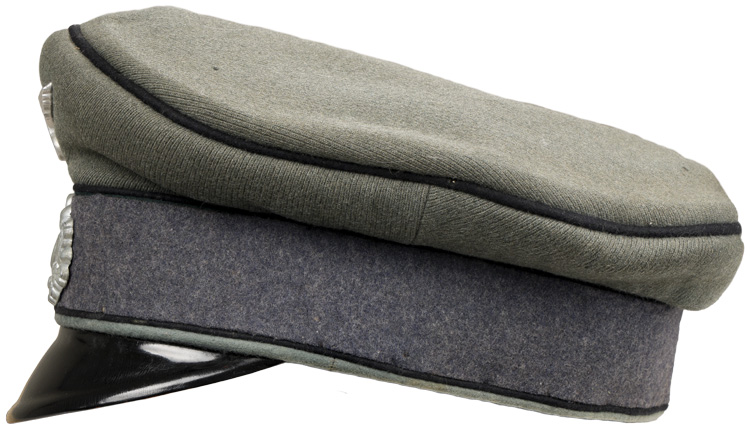
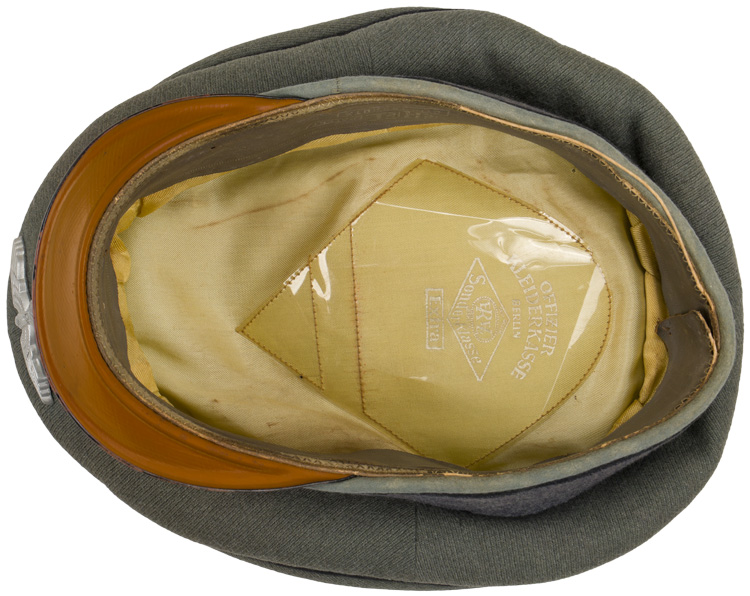
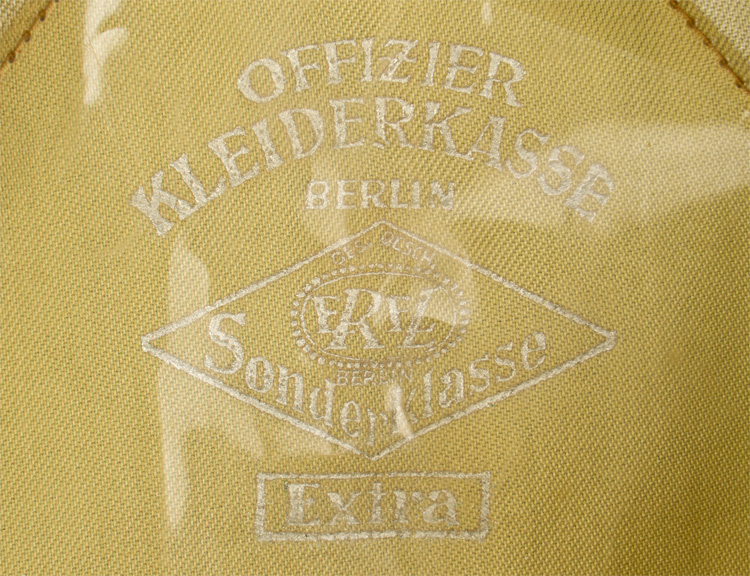
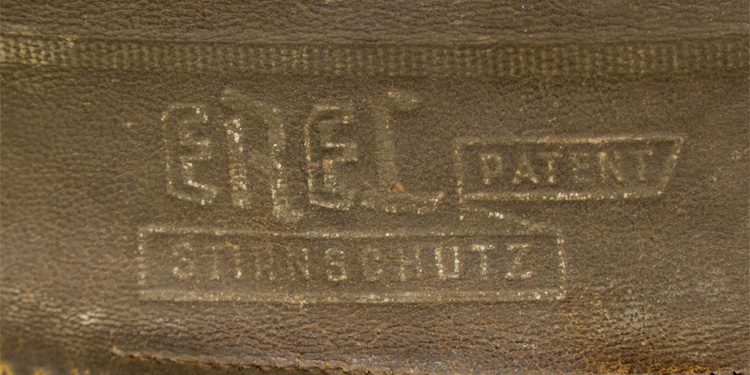
H063777 SONDERFÜHRER OFFICER'S VISOR CAP.
(Schirmmütze)BACKGROUND: Visor caps were a standard item for all personnel during the Third Reich period and regulations dictated the form of dress they were to be worn with based on the individuals rank. Officers and certain senior NCO ranks were responsible for purchasing their own caps and as a result were allotted a clothing allowance through the army’s Kleiderkasse, (Clothing Account), system. The Officers and certain senior NCO’s could choose to purchase their caps from the armed forces clothing depots or to privately purchase visor caps of higher quality. Although enlisted personnel were issued their caps from government supplies they were also permitted to purchase privately tailored caps although the price may have been restrictive. Originally the insignia worn on the visor caps consisted the Weimar Reichsheer patterns which included a blackened leather chinstrap for all ranks. In February 1927 new chin cords for Officer ranks were introduced with silver cords for the ranks of Leutnant to Oberst and gilt cords for the ranks of Generalmajor to Generalfeldmarschall. Regulations of February 26TH 1936 also permitted senior NCO’s who were Officer Candidates to wear the Officers twisted silver/aluminum chin cord on their visor caps as opposed to the standard EM/NCO’s leather chinstrap. Of Note: Both the first pattern Reichsheer era visor cap eagle and wreath were replaced with the second pattern in March 1935. The Army Mobilization Order of March 12TH 1937 established a group of Sonderführer, (Specialist Leaders), formed from personnel with specialized knowledge and/or skills to perform specific tasks that regular military personnel were unable to fulfill. Depending on their qualifications the Sonderführers were assigned positions with the equivalent of NCO or Officers ranks although since they lacked the prerequisite military training their authority only extended to personnel serving with them in the performance of a particular task or function. The Sonderführers were divided into five different position groups with each group being roughly the equivalent of a military unit running from Battalion level down to Squad level. The Sonderführers position/rank was dependant on the position group that the individual was assigned to. Originally the Sonderführers wore the standard army uniform and headgear befitting their position/rank with the appropriate identifying, waffenfarbe, (Branch of Service Color), which was generally displayed as piping on the visor cap, with dark green being allocated to Administrative personnel. Regulations of July 1941 altered the waffenfarbe color of all Sonderführers to blue/grey and included altering the standard blue/green visor cap centerband color. The German army had a tradition, dating from the 1700's, of maintaining a separate branch of Administrative Official’s attached to the army to oversee all administrative functions, thus freeing up active army Officers and allowing them to concentrate on actual military matters. The Officials were responsible for a wide variety of administrative tasks from Court Martial, Librarian, Supply, Technical and Meteorological Services, to School, Barracks, and Hospital administration. Most officials careers consisted of four varying grades, of high, elevated, medium and low grade with slightly differing identifying insignia for each grade. The grade of the career was determined by the education and/or experience of the individual. During the Reichswehr era the officials were divided into military and civilian personnel until December 22ND 1934 when the German High Command did away with the differentiation and consolidate all the officials into the newly formed Wehrmachtbeamte-Heer, (Armed Forces Officials-Army). Regulations of March 12TH 1937 reorganized the Officials and instituted the new Beamte auf Kriegsdauer a.K., (Wartime Official’s for the duration of the war), to be activated in times of mobilization. Originally the uniformed Official’s were allotted an identifying dark green waffenfarbe, (Branch of Service Color), with a nebenfarbe, (secondary color), to indicate their actual career. Regulations of March 21ST 1940, replaced the assorted nebenfarbe colors with a secondary color of light grey for all Officials regardless of career or function. In January 1944 the Army instituted a new career for officers and certain officials, entitled, TSD, "Truppensonderdienst", (Special Service). This new career used light blue waffenfarbe and did away with secondary colors as worn by Officials in the other careers.
PHYSICAL DESCRIPTION: Officer’s visor cap with a, field-grey wool construction body and crown, a blue/grey wool centerband (period added over the top of the original centerband) and black (Pioneer) waffenfarbe piping to the top crown edge and both the top and bottom edges of the centerband. Aluminum national eagle and zinc alloy cockade. Cap never had a chincord added and was worn in the "crusher" style. The cap has an extended, forward, black lacquered vulcanfibre visor with a subtly raised lip to the forward edge. The interior of the cap is fully lined in two grades of gold rayon. Nicely double Erel marked and still has its original untouched sweat diamond. Nice complete original leather sweatband. Roughly a size 57". Nice worn and used example showing the expected age and wear.
GRADE **** PRICE $1,255.00 (Or Best Offer)
To Order this item, please use one of the two e-mail addresses below to contact us. Please make sure to quote the item number in your e-mail
MILITARIA WANTED! If you have items for sale, please contact us. We specialize in selling single pieces and entire collections. Over 3 decades in the business and we do all the work for you. Get the best return for your investment.
-E-Mail Address pawmac@nbnet.nb.ca Or guild@nb.aibn.com
To return to the main page please CLICK below